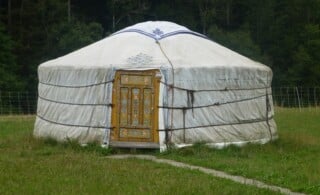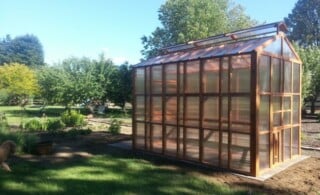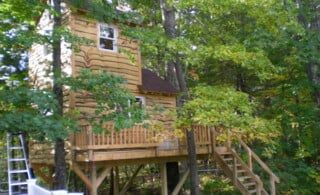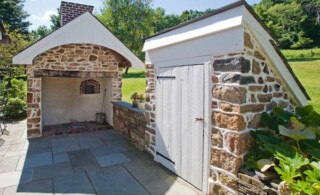As an amateur equestrian, the most important thing to learn is not how to ride a horse. It’s how to care for one. After all, a healthy horse is the most basic requirement for any equestrian activity, and the thing that plays the biggest role in your horse’s well-being is how and where you choose to house him.
If you live on a large plot of land, you can certainly keep your equine close to home. But don’t worry: even if you live in a tiny apartment in the middle of the city with green space the size of a postage stamp, you have options for safely housing your horse, including buying a farm, building a barn, or boarding.
As you weigh your options, it’s important to set your expectations and choose your facility with the needs of both you and your horse in mind. We’ll provide tips, tricks, and legal requirements you should know.
On This Page:
- Barn or Board?
- Best Stable Practices
- Indoor vs. Outdoor vs. Combo
- Stall Types
- Stall Sizes
- Bedding
- Fencing
- Lighting
- Pasture
- Legalities
Getting Started
What do both you and your horse need? Answer this question before you determine what type of housing you should pursue. Like other pets, your horse will need space to roam and shelter from the elements. While other amenities may make you more comfortable as you care for him, they are entirely optional for your animal.
What you plan on doing with your horse also factors into your decision. If you want to ride daily, you may want to keep your horse nearby. For casual riding during good weather, a three-sided shelter might serve you well. However, if you’ll be showing your horse, consider a covered arena to use for conditioning. As a general trend, the more you expect from your horse, the fancier your facilities will need to be. How complex it his home is also depends on your budget.
Here’s are some budget estimates.
Barn
Perhaps you want to raise a new barn for your horse. Building a barn costs at least $7 per square foot. Renovating an existing one could cost a little less depending on its condition. If you need to purchase land, hire a contractor to add fencing, or do other site work. Either way, housing him yourself means you’ll spend more up front. It also means that you’ll have to commit time or money to ensuring he is eating and exercising regularly.
Board
Boarding your horse at a local stable has month-to-month costs for its convenience. For basic services, expect to pay between $200 and $450 per month.
Facility Selection
Whether you decide to house your horse on your property or pay to board him, the facility where he’ll spend his days (and nights) must adhere to the minimum standards for the housing and care of horses:
- Horses should have access to a constructed shelter with a minimum of three sides at all times to protect them from the sun, rain, wind, and inclement weather.
- The roof of the shelter should be waterproof.
- Your horse must be able to stand upright in his normal position within the shelter, which should allow for safe head clearance and be able to accommodate all animals comfortably at all times.
- The shelter floor should be dry, allowing the animals to lie down.
- Extra protection, in the form of improved housing, blankets, and other methods, should be provided if the animal’s health is compromised in any way.
- Indoor shelters must be adequately ventilated to prevent excess dust or moisture that may threaten the animal’s health.
Moreover, the facility should be well-constructed, properly placed, and possess stalls of the appropriate size for your horse.
Construction
The type of barn you choose will depend on how you use your horse, as well as the weather where you live. Costs and maintenance requirements will vary, depending on whether you choose indoor, outdoor, or combination housing.
- Indoor housing is best if you will ride your horse every day in cold weather. Manure removal must be done daily, and hay should be stored A single-story barn is typically the least expensive indoor housing structure to build and maintain.
- Outdoor housing, including three-sided sheds, allow you to keep your animals in the open air but still protect them from the weather. This type of housing works best in mild climates and with groups of horses that get along well together. Outdoor structures cost less to build or buy and require less labor to clean because you can use a skid steer instead of doing it manually.
- Combination housing combines the features, advantages, and benefits of both indoor and outdoor structures, but the convenience comes at an added cost. Two structures are more expensive — and require more land — than one.
Placement
One of the essential features of a well-designed facility is drainage. Whether you are boarding, building, or buying, the barn or shed should be elevated at least one foot above the surrounding ground. If not, barn flooding and excessive moisture can mean health concerns for your horses, including hoof problems and allergies caused by mold. Excess moisture also threatens the stability of the structure.
From a legal perspective, you will need to ensure you check with your local zoning board about the placement of your structure. In some instances, local regulations may dictate how close you can build or place your building to property lines, bodies of water, or other structures on the property. These laws protect the environment and other property owners.
Stalls
Stalls are a necessity for keeping horses contained, especially when multiple horses are being housed at a single location. However, they must be constructed in a way that allows the animals enough space and keeps them safe and comfortable. There are three main types of stalls to choose from, including tie stalls, box stalls, and open shed rows.
Tie
Tie stalls are also called standing stalls. They are great when space is limited. You may tie horses with a chain or rope, or the animal may stand loose with two chains across the open end of the stall. Tie stalls should be at least 5 feet wide and 10 feet long. Since there is limited room to move, these stalls are only appropriate for calm horses who can stand quietly. Horses should be exercised and turned out daily.
Box
Box stalls are wider than tie stalls, relative to the size of the horse, and therefore allow for more freedom of movement. One tip is to include a removable wall in between each stall that will allow you to increase the size of the stall to accommodate a larger horse or a mare and her foals.
|
Miniature horse |
6’ x 8’ |
|
Ponies and horses weighing less than 900 lbs |
10’ x 10’ |
|
Riding horses weighing between 900 and 1,100 lbs |
12’ x 12’ |
|
Warmblood or small draft |
12’ x 14’ |
|
Large draft |
16’ x 16’ |
|
Foaling stall |
Twice the size of a single stall for the horse |
Open Shed Rows
These are like box stalls, but the doors are open to the outside. Owners typically use dutch doors to promote ventilation.
Builders should construct the stalls of hardwood and treat them to deter chewing. Stall floors should be forgiving to the animal’s legs, drain well, and prevent slipping. Ideally, stall floors will have a crushed-rock base covered with clay or field lime.
Sometimes, boarders use sand or soil, but these are less stable and may develop holes or low spots. Although cement and asphalt are easier to clean, they are not ideal because they are hard and do not drain well. If you must use them, you should use rubber mats and 8 to 10 inches of bedding.
Equip all stalls with water and food containers.
Other Concerns
Of course, housing your horse is not just about the building itself. Bedding, fencing, lighting, and pasture space also come into play. Like with the structure, how you choose to outfit your animal’s quarters depends mostly on budget and weather.
Bedding
Aim for 3 to 4 inches of bedding, unless you have an asphalt or cement floor. In that case, you’ll need 8 to 10 inches.
Many owners choose to use wood shavings or straw to insulate stalls and provide a soft place for their horse to land. However, these materials are often expensive and difficult to get. Luckily, there are many acceptable options, including:
- Peat moss
- Rice hulls
- Peanut hulls
- Sawdust
- Paper pulp
Avoid black walnut wood shavings that are toxic to horses.
Regardless of the type, ensure his bedding is clean and dust-free.
Fencing
The more your horse can roam free, the healthier he’ll be. Fencing plays a key role in that, but you must select a style and type that keeps your horse secure. Materials that keep your costs and maintenance low are also a plus. The most common types of fencing are:
- Wooden post and rail – This option is the most costly and labor-intensive option, but it is also the most natural and visually appealing.
- Polyvinyl chloride (PVC) – This option is also expensive, but the maintenance is significantly less than it would be for a wooden fence.
- Wire – Wire fencing is less expensive than other options and requires little maintenance. However, it can cause injury to your horse if he gets caught or tangled.
Fencing should be at least 4 feet high, and it should hold up to leaning and rubbing by horses. It should also be highly visible. The greatest risk associated with a fence is injury to your animal should he run into it. Installing horse farm fencing costsbetween $2,075 and $2,230 for labor and materials. Hire a local fence contractor with experience in farm fencing to help you determine the type that will work best for you and your animal.
Lighting
Ample lighting will make your barn easier to work in at all hours of the day. Position windows and skylights to allow plenty of natural light, but make sure to provide shutters or other coverings to keep out sun and precipitation. For early morning cleaning and late-night chores, you’ll want to install an alternative light in every stall. Just make sure there are no exposed wires or other components.
Pasture Space
What is your horse’s primary source of nutrition? If he’ll eat from your pasture, it has to be large enough—at least one to two acres per riding-size horse. Overgrown pastures don’t provide sufficient nutrients. Maintain the quality of the forage by mowing regularly to reduce weeds. If your field is not the proper size or quality to produce enough food, be sure to supplement his diet.
Legalities
Beyond ensuring your horse’s housing meets the minimum standards, you should also take care to legally protect yourself, your animal, and any other animals on the property. This is especially important if you are boarding your animal offsite, using a barn or property that is not your own, or housing other people’s horses on your property. Start with these tips:
- Liability insurance – In the event a horse is lost or injured, you’ll need to establish who is at fault. Having the property-liability insurance will protect you whether you’re a horse owner or boarder.
- Releases – Anyone who is using your horse or your property should sign a release to do so. Always have your lawyer review your document to check that it complies with state law.
- Risk management – Be proactive by keeping your facility secure and in good shape. You should also post any signage required by law.
On top of being a sizable investment of money and time, a horse is an investment of the heart. That’s why if you’re an amateur equestrian, the idea of housing a horse in a way that will keep him happy and healthy can be overwhelming. However, if you do your research and put the needs of your horse first, taking care of him will be gratifying and help him live a long and healthy life.

 Portable, Versatile Yurts
Portable, Versatile Yurts  Greenhouse Essentials You Need To Know
Greenhouse Essentials You Need To Know  Benefits of Pressure-Treated Wood
Benefits of Pressure-Treated Wood  Build a Tree House for Your Kids
Build a Tree House for Your Kids  Expand your Land with Outbuilding Plans
Expand your Land with Outbuilding Plans 

I enjoyed the article about housing horses. I would like to add that electric fencing is a relatively inexpensive option to consider. It has come a long way from just wire. It comes in tape of different widths that are easy to install.
Consider turn out a necessity even for show horses. Grazing, fresh air, and being with a herd is how “mother nature” gave us horses.
They learn human cues and learn our language. But when we allow them to be themselves, they have their own language, herd behavior and dominance. They are sensitive, intelligent, intuitive creatures capable of many things we didn’t believe they could do before.
They dance, paint, open stall doors, let their friends out and go for walks. They are curious, shy or want our attention. They need companionship and are often fear being all alone. We need to build to suit our tenants and recognize riding them is work and is only a single aspect in the life of a horse.